高中英语人教版必修4 Unit4 Body language Period3 Learning about Language语法专题课课件(32张)
文档属性
| 名称 | 高中英语人教版必修4 Unit4 Body language Period3 Learning about Language语法专题课课件(32张) | 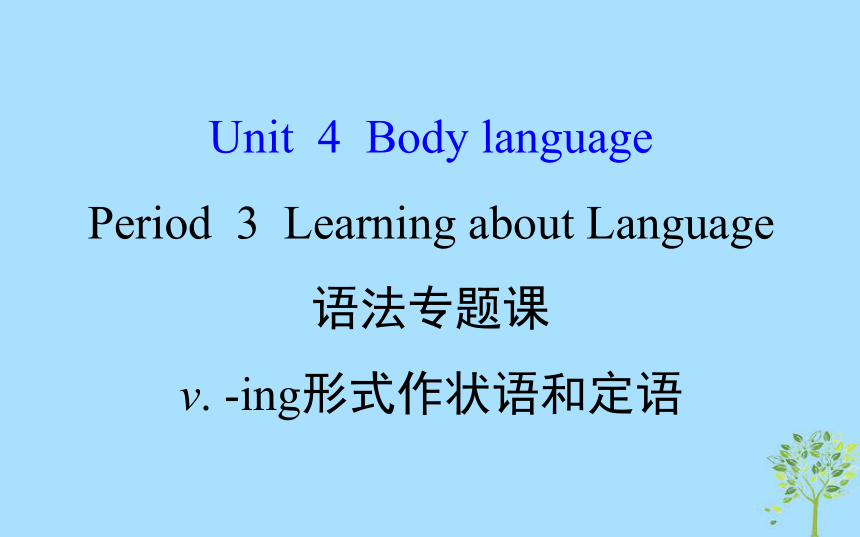 | |
| 格式 | zip | ||
| 文件大小 | 238.4KB | ||
| 资源类型 | 教案 | ||
| 版本资源 | 人教版(新课程标准) | ||
| 科目 | 英语 | ||
| 更新时间 | 2019-02-20 17:12:09 | ||
图片预览


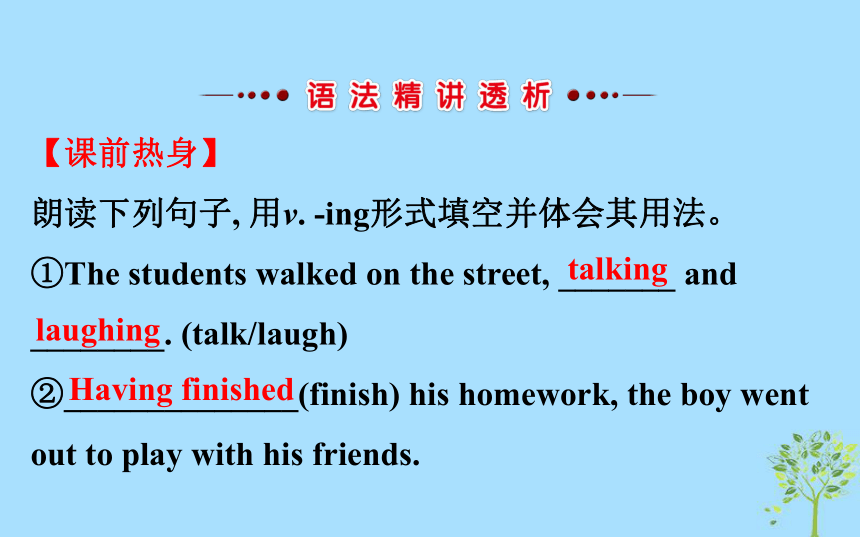

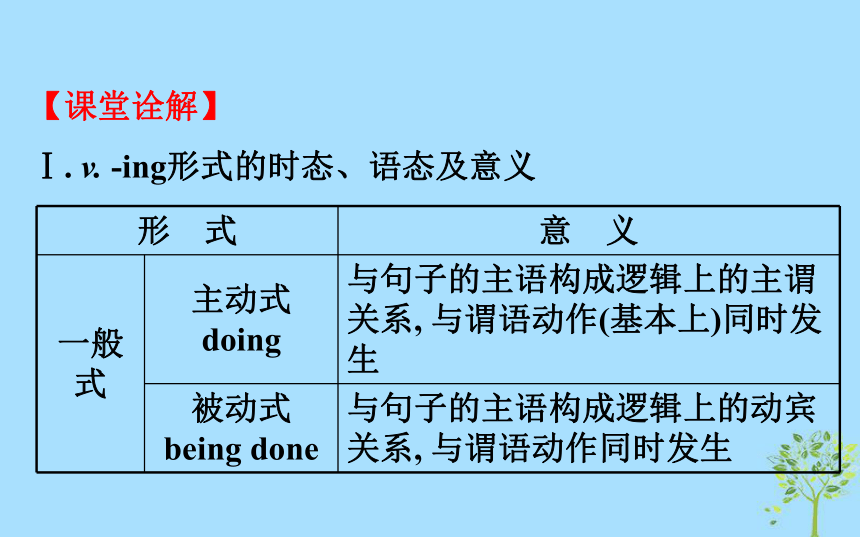
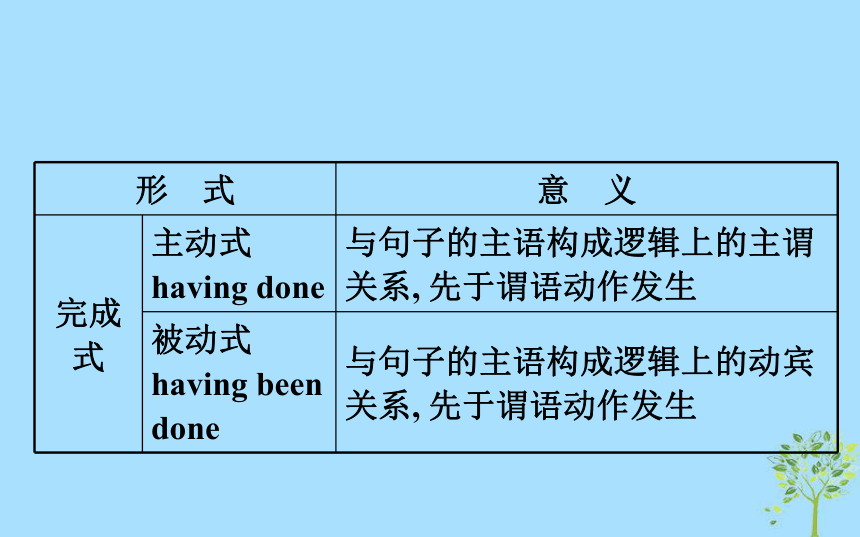
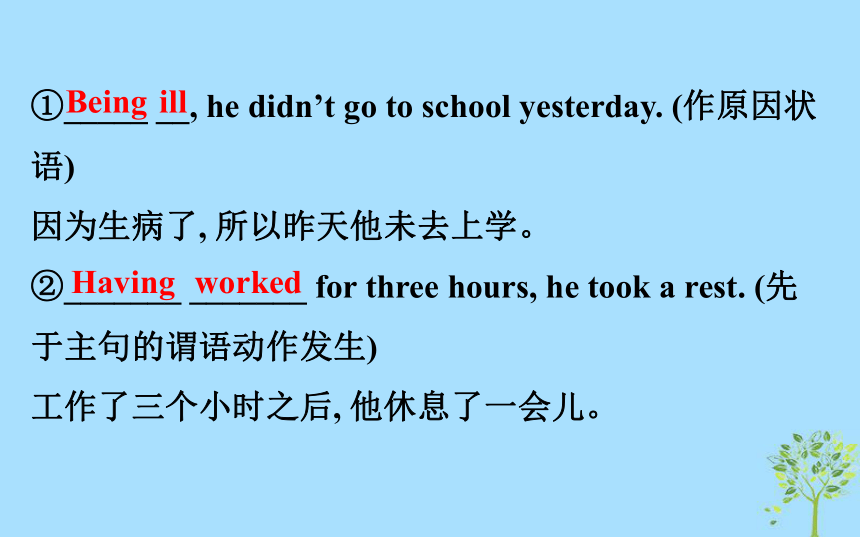
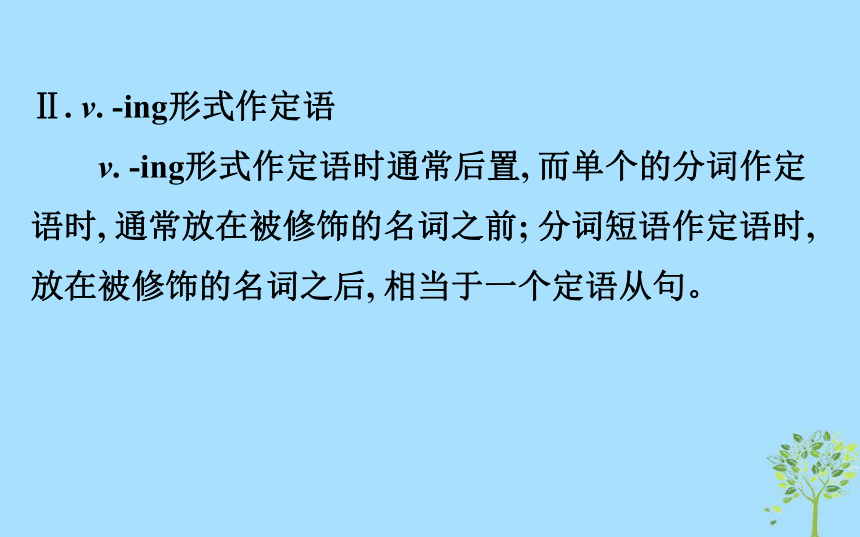
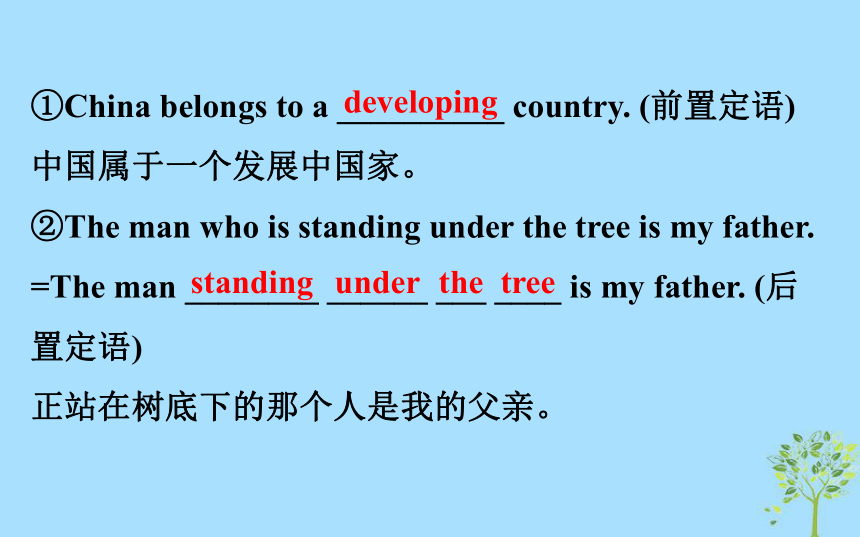


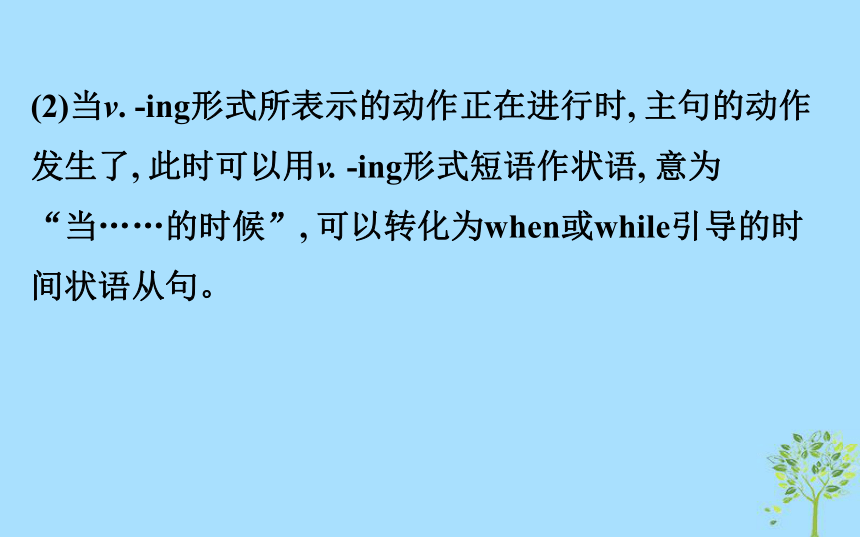
文档简介
课件32张PPT。Unit 4 Body language
Period 3 Learning about Language
语法专题课
v. -ing形式作状语和定语【课前热身】
朗读下列句子, 用v. -ing形式填空并体会其用法。
①The students walked on the street, _______ and
________. (talk/laugh)
②______________(finish) his homework, the boy went
out to play with his friends. talkinglaughingHaving finished③The boy ________ (stand)there is a classmate of mine.
④________ (look)carefully, I made my way to the edge
of the forest.
⑤The boy rushed into the _______ (burn)woods to save
the animals.
结论: 在上面的句子中, 作定语的有: _____; 作状语的有:
_______standingLookingburning③⑤①②④【课堂诠解】
Ⅰ. v. -ing形式的时态、语态及意义①_____ __, he didn’t go to school yesterday. (作原因状
语)
因为生病了, 所以昨天他未去上学。
②_______ _______ for three hours, he took a rest. (先
于主句的谓语动作发生)
工作了三个小时之后, 他休息了一会儿。BeingillHavingworkedⅡ. v. -ing形式作定语
v. -ing形式作定语时通常后置, 而单个的分词作定语时, 通常放在被修饰的名词之前; 分词短语作定语时, 放在被修饰的名词之后, 相当于一个定语从句。①China belongs to a __________ country. (前置定语)
中国属于一个发展中国家。
②The man who is standing under the tree is my father.
=The man ________ ______ ___ ____ is my father. (后
置定语)
正站在树底下的那个人是我的父亲。developingstandingunderthetreeⅢ. v. -ing形式作状语
v. -ing形式在句中作状语时, 表示的动作是主语动作的一部分, 用来修饰谓语动词, 常表示动作发生的时间、原因、条件、结果、方式、伴随、让步等情况, 并可以转换成相应的状语从句或并列句。1. 作时间状语。
(1)当v. -ing形式所表示的动作一发生, 主句的动作也随
之发生时, 可以用v. -ing形式作状语, 意为“一……”, 可
以转化为“on+v. -ing”结构。
Hearing the news, they couldn’t help jumping.
=___ _______ the news, they couldn’t help jumping.
听到这个消息, 他们禁不住跳起来。Onhearing(2)当v. -ing形式所表示的动作正在进行时, 主句的动作发生了, 此时可以用v. -ing形式短语作状语, 意为“当……的时候”, 可以转化为when或while引导的时间状语从句。①Be careful _____ _______ the street.
过马路时一定要小心。
②Don’t mention this _____ _______ to him.
与他交谈时不要提这件事。whencrossingwhiletalking(3)当v. -ing形式所表示的动作完成以后, 主句的动作才发生时, 用v. -ing形式的完成式, 意为“在……之后”, 可以转化为after引导的时间状语从句。After he finished his homework, Tom listened to music
for a while.
=_______ _______ his homework, Tom listened to
music for a while.
完成作业后, 汤姆听了一会儿音乐。Havingfinished2. 作原因状语。
(1)当v. -ing形式所表示的动作和谓语动词所表示的动作同时发生时, 用v. -ing形式的一般式, 即doing。
(2)当v. -ing形式所表示的动作在谓语动词所表示的动作之前发生时, 用v. -ing形式的完成式, 即having done。(3)可以转化为as, since, because等引导的原因状语从
句。
①Because she hasn’t finished her task in time, she was
fired by the boss.
=____ ______ _______ her task in time, she was fired
by the boss.
由于没有按时完成任务, 她被老板解雇了。Nothavingfinished②Because they don’t know my cell phone number,
they couldn’t get in touch with me.
=____ ________ my cell phone number, they couldn’t
get in touch with me.
由于不知道我的手机号码, 他们无法跟我取得联系。Notknowing【名师指津】v. -ing形式的否定形式
v. -ing形式的否定形式是“not+v. -ing”; 其完成式的否定形式通常把not放在having的前面。3. 作条件状语。
动词-ing形式作条件状语时, 可以转换为if, unless等引
导的条件状语从句。
①If you use your head, you’ll have a good idea.
=_____ _____ _____, you’ll have a good idea.
如果你动动脑筋, 你就会想出好办法来。Usingyourhead②If you study hard, you will pass the college entrance
examination.
=________ _____, you will pass the college entrance
examination.
如果你努力学习, 你就会通过高考。Studyinghard4. 作方式或伴随状语。
v. -ing形式作方式状语, 又被称为伴随状语, 两个动作一般是同时发生的, 没有相应的状语从句, 一般可转换成并列分句。①The girls followed their parents and came in.
=The girls came in, ________ their parents.
那些女孩子们跟在她们的父母后面进来了。following②(2016·全国卷Ⅲ)People probably cooked their food in large pots, ______(use)twigs(树枝)to remove it.
【解析】using。考查非谓语动词。use和句子主语people之间是主动关系, 所以用现在分词。此处现在分词作方式状语。5. 作让步状语。
动词-ing形式作让步状语时, 可以转换为although,
though等引导的让步状语从句。
Although he worked very hard, he didn’t feel a bit
tired.
=________ ____ _____, he didn’t feel a bit tired.
尽管拼命地工作, 他却丝毫不感到疲劳。Workingveryhard6. 作结果状语。
(1)v. -ing形式作结果状语时, 通常放在句中, 中间用逗号隔开, 表示一种自然的结果。可以用so that引导的结果状语从句替换。①The heavy rain lasted three days so that it resulted in
serious traffic confusion in the whole city.
=The heavy rain lasted three days, ________ __ serious
traffic confusion in the whole city.
大雨下了三天, 造成整个城市交通瘫痪。resultingin②(2016·北京高考)Newly-built wooden cottages line the street, ______(turn) the old town into a dreamland. 【解析】turning。考查非谓语动词。句意: 街道两旁都是新建的木屋, 使这个古旧小镇变成了梦幻之地。根据句意和结构可知, 主句的内容与动词turn有逻辑上的主谓关系, 表示产生的自然结果, 故应该使用-ing形式作结果状语。(2)v. -ing形式作结果状语与不定式作结果状语的区别:
不定式作结果状语时, 结果一般是不好的或者是出人意
料的结果, 常在不定式的前面加上only。
He rushed all the way to the station, ____ __ ____the
train.
他一路冲往车站, 结果还是错过了火车。onlytomiss【课堂小结】
一、v. -ing形式作定语
1. 表示被修饰词的某种用途, 放于名词前, 意思是“供……用”, 可改为for短语。
2. 表示所修饰名词的动作或状态, 相当于一个定语从句。二、v. -ing形式作状语
v. -ing形式作状语时, 可以表示时间、原因、结果、条件、让步、方式或伴随动作等, 除作伴随状语外, 相当于与之对应的状语从句; 而作伴随状语时, 可转化为并列句。
Period 3 Learning about Language
语法专题课
v. -ing形式作状语和定语【课前热身】
朗读下列句子, 用v. -ing形式填空并体会其用法。
①The students walked on the street, _______ and
________. (talk/laugh)
②______________(finish) his homework, the boy went
out to play with his friends. talkinglaughingHaving finished③The boy ________ (stand)there is a classmate of mine.
④________ (look)carefully, I made my way to the edge
of the forest.
⑤The boy rushed into the _______ (burn)woods to save
the animals.
结论: 在上面的句子中, 作定语的有: _____; 作状语的有:
_______standingLookingburning③⑤①②④【课堂诠解】
Ⅰ. v. -ing形式的时态、语态及意义①_____ __, he didn’t go to school yesterday. (作原因状
语)
因为生病了, 所以昨天他未去上学。
②_______ _______ for three hours, he took a rest. (先
于主句的谓语动作发生)
工作了三个小时之后, 他休息了一会儿。BeingillHavingworkedⅡ. v. -ing形式作定语
v. -ing形式作定语时通常后置, 而单个的分词作定语时, 通常放在被修饰的名词之前; 分词短语作定语时, 放在被修饰的名词之后, 相当于一个定语从句。①China belongs to a __________ country. (前置定语)
中国属于一个发展中国家。
②The man who is standing under the tree is my father.
=The man ________ ______ ___ ____ is my father. (后
置定语)
正站在树底下的那个人是我的父亲。developingstandingunderthetreeⅢ. v. -ing形式作状语
v. -ing形式在句中作状语时, 表示的动作是主语动作的一部分, 用来修饰谓语动词, 常表示动作发生的时间、原因、条件、结果、方式、伴随、让步等情况, 并可以转换成相应的状语从句或并列句。1. 作时间状语。
(1)当v. -ing形式所表示的动作一发生, 主句的动作也随
之发生时, 可以用v. -ing形式作状语, 意为“一……”, 可
以转化为“on+v. -ing”结构。
Hearing the news, they couldn’t help jumping.
=___ _______ the news, they couldn’t help jumping.
听到这个消息, 他们禁不住跳起来。Onhearing(2)当v. -ing形式所表示的动作正在进行时, 主句的动作发生了, 此时可以用v. -ing形式短语作状语, 意为“当……的时候”, 可以转化为when或while引导的时间状语从句。①Be careful _____ _______ the street.
过马路时一定要小心。
②Don’t mention this _____ _______ to him.
与他交谈时不要提这件事。whencrossingwhiletalking(3)当v. -ing形式所表示的动作完成以后, 主句的动作才发生时, 用v. -ing形式的完成式, 意为“在……之后”, 可以转化为after引导的时间状语从句。After he finished his homework, Tom listened to music
for a while.
=_______ _______ his homework, Tom listened to
music for a while.
完成作业后, 汤姆听了一会儿音乐。Havingfinished2. 作原因状语。
(1)当v. -ing形式所表示的动作和谓语动词所表示的动作同时发生时, 用v. -ing形式的一般式, 即doing。
(2)当v. -ing形式所表示的动作在谓语动词所表示的动作之前发生时, 用v. -ing形式的完成式, 即having done。(3)可以转化为as, since, because等引导的原因状语从
句。
①Because she hasn’t finished her task in time, she was
fired by the boss.
=____ ______ _______ her task in time, she was fired
by the boss.
由于没有按时完成任务, 她被老板解雇了。Nothavingfinished②Because they don’t know my cell phone number,
they couldn’t get in touch with me.
=____ ________ my cell phone number, they couldn’t
get in touch with me.
由于不知道我的手机号码, 他们无法跟我取得联系。Notknowing【名师指津】v. -ing形式的否定形式
v. -ing形式的否定形式是“not+v. -ing”; 其完成式的否定形式通常把not放在having的前面。3. 作条件状语。
动词-ing形式作条件状语时, 可以转换为if, unless等引
导的条件状语从句。
①If you use your head, you’ll have a good idea.
=_____ _____ _____, you’ll have a good idea.
如果你动动脑筋, 你就会想出好办法来。Usingyourhead②If you study hard, you will pass the college entrance
examination.
=________ _____, you will pass the college entrance
examination.
如果你努力学习, 你就会通过高考。Studyinghard4. 作方式或伴随状语。
v. -ing形式作方式状语, 又被称为伴随状语, 两个动作一般是同时发生的, 没有相应的状语从句, 一般可转换成并列分句。①The girls followed their parents and came in.
=The girls came in, ________ their parents.
那些女孩子们跟在她们的父母后面进来了。following②(2016·全国卷Ⅲ)People probably cooked their food in large pots, ______(use)twigs(树枝)to remove it.
【解析】using。考查非谓语动词。use和句子主语people之间是主动关系, 所以用现在分词。此处现在分词作方式状语。5. 作让步状语。
动词-ing形式作让步状语时, 可以转换为although,
though等引导的让步状语从句。
Although he worked very hard, he didn’t feel a bit
tired.
=________ ____ _____, he didn’t feel a bit tired.
尽管拼命地工作, 他却丝毫不感到疲劳。Workingveryhard6. 作结果状语。
(1)v. -ing形式作结果状语时, 通常放在句中, 中间用逗号隔开, 表示一种自然的结果。可以用so that引导的结果状语从句替换。①The heavy rain lasted three days so that it resulted in
serious traffic confusion in the whole city.
=The heavy rain lasted three days, ________ __ serious
traffic confusion in the whole city.
大雨下了三天, 造成整个城市交通瘫痪。resultingin②(2016·北京高考)Newly-built wooden cottages line the street, ______(turn) the old town into a dreamland. 【解析】turning。考查非谓语动词。句意: 街道两旁都是新建的木屋, 使这个古旧小镇变成了梦幻之地。根据句意和结构可知, 主句的内容与动词turn有逻辑上的主谓关系, 表示产生的自然结果, 故应该使用-ing形式作结果状语。(2)v. -ing形式作结果状语与不定式作结果状语的区别:
不定式作结果状语时, 结果一般是不好的或者是出人意
料的结果, 常在不定式的前面加上only。
He rushed all the way to the station, ____ __ ____the
train.
他一路冲往车站, 结果还是错过了火车。onlytomiss【课堂小结】
一、v. -ing形式作定语
1. 表示被修饰词的某种用途, 放于名词前, 意思是“供……用”, 可改为for短语。
2. 表示所修饰名词的动作或状态, 相当于一个定语从句。二、v. -ing形式作状语
v. -ing形式作状语时, 可以表示时间、原因、结果、条件、让步、方式或伴随动作等, 除作伴随状语外, 相当于与之对应的状语从句; 而作伴随状语时, 可转化为并列句。
同课章节目录
